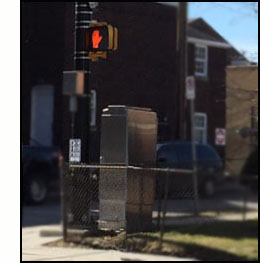 What's this all about? And why the heck should we care?
What's this all about? And why the heck should we care?
-
Whew -- now that you understand about the traffic movements and timing of typical modern signals, you probably realize that they ain't your grandfather's signals!
- developed actuated signals that require pedestrians to know when they've been provided with enough time to cross, and
- designed some new traffic patterns to accommodate the left-turning and right-turning traffic, which means that signals have to specify exactly who is allowed to move and who isn't.
"Back in the day, Sonny," your grandfather might tell you (if he was an engineer!), there was no need for any pedestrian signals because pedestrians were treated the same as vehicles. There was one signal for each approach to the intersection (each "leg"), and the green, yellow and red signals were intended for ALL traffic entering or crossing the intersection from that direction -- vehicles, pedestrians and bicyclists. The law specified (and it was commonly understood, if not obeyed) that drivers who have the green signal and are turning need to yield to pedestrians who also have the green signal.
So the pedestrian signal was the same as the vehicular signal. That's what made it so easy for blind pedestrians to know when their signal was green - they knew that if it was green for the vehicles on the parallel street beside them, regardless of which direction they were going, it was green for them, too. So all they needed to do was determine when the parallel traffic in either direction started to move, and they'd know they had the green signal. Of course when Right-Turn-On-Red laws were enacted, they could no longer infer that the signal was green if the only movement in the parallel traffic was a vehicle turning right, but they could still be confident that if any parallel vehicles moved straight or turned left from either direction, the pedestrians also had the green signal.
But you now know that the "good-ol' days" are gone, and the engineers
And when the traffic is given a green arrow to allow it to turn left, the engineers needed to make sure that those vehicles wouldn't conflict with the pedestrians who were crossing parallel to them. So those pedestrians had to have their own signal to let them know when they had the right-of-way, and when the turning vehicles had the right-of-way.
And so the need for a pedestrian signal was born. Pedestrian signals are required whenever there is a conflict in the right-of-way of drivers and pedestrians who are facing the same signal. They are also needed at actuated signals where the green ball signifies enough time for vehicles to cross, but not enough time for pedestrians.
Do blind people need to know what the pedestrian signal says?
- The short answer is: YES! To illustrate our point, we want to share a story from one of the authors. Dona Sauerburger writes:
I had taught the woman that she can cross as soon as she hears any surge of traffic on the parallel street (other than right-turning traffic). So as soon as she heard traffic on the far lanes of the parallel street surge forward, she moved her white cane and started to cross. I was pleased that she was doing so well, and happened to look up and see that the pedestrian signal said "DON'T WALK." I vividly remember exactly what went through my mind. Within a fraction of a second, I thought, "Oh, that's odd! But blind people cannot see the pedestrian signal, so they can't be expected to obey it, right? So it's okay for them to ignore it, and cross the traditional way that we teach them." OH MY GOODNESS! The drivers apparently disagreed - it was summer and the windows were down, and some were leaning out and yelling and making ferocious faces, others were honking as if to say "HEY! It's MY turn, take your cane and get off the street, lady!" We made it across the street and talked about how rude those drivers were, but I remember thinking, "YIKES! I wonder if their rudeness and aggression had something to do with the fact that the pedestrian signal said, 'DON'T WALK'? Maybe we better figure out how the heck blind people can know what the darned pedestrian signal says!" It wasn't until several years later that some O&M instructors figured it out (as explained in the section on traffic patterns). I learned about it when I happened to be substituting for one of those instructors, and I asked her teenage student why she wasn't crossing when she heard the surge of parallel traffic. "Oh, Mrs. Sauerburger," she replied with some dismay that I would even suggest such a thing, "Mrs. Frieswick told me to wait until I hear the sound of the parallel traffic in the nearest lanes." |
White cane laws
Ah, we hear you asking "But in the U.S., doesn't the white cane law in most states say that blind pedestrians have the right-of-way? They don't need to obey the signals, do they?"
Well…..the laws regarding pedestrian crossings at signalized intersections and the white cane laws of most states conflict. While the white cane laws seem to give the right-of-way to a person who is blind, a driver who is making a left turn with a green arrow is not generally expecting pedestrians to be crossing the street, and doesn't consider that pedestrians have the right-of-way. You can see in our video, when Dona crosses at the wrong time (without a white cane), drivers tell her that THEY have the right-of-way, and this expectation is often extended to people with white canes, as Dona experienced in her story. Also, there are many situations where other traffic can block a driver's view of the pedestrian crossing.
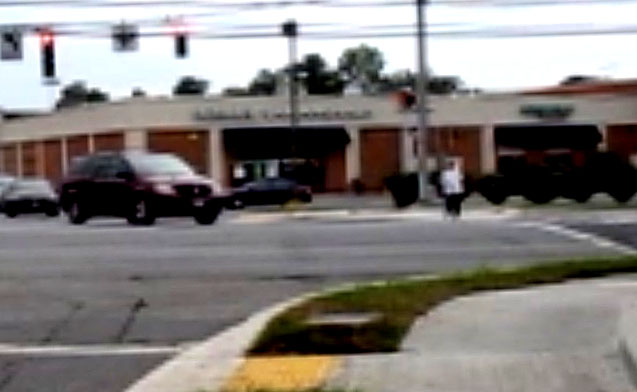
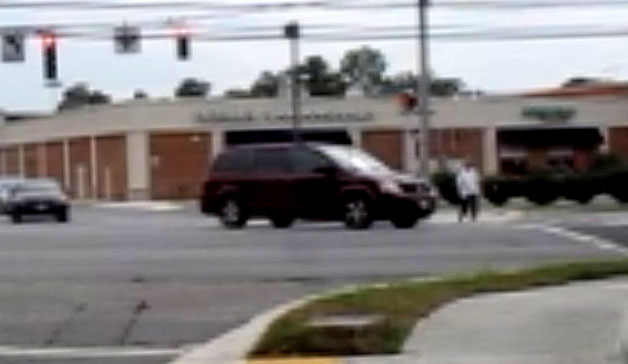
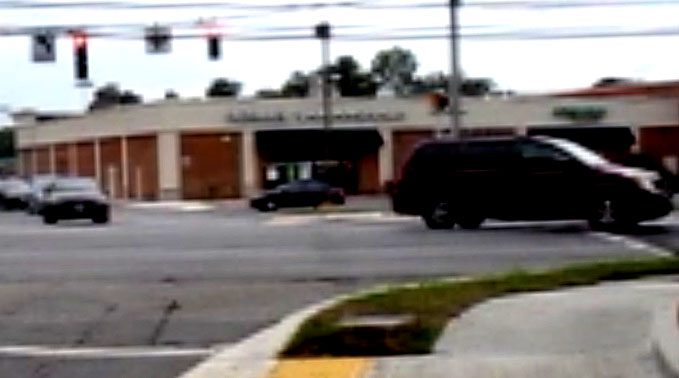
Pictures from the video show Dona crossing when vehicles which have the right-of-way are
cutting across her path. One of the drivers yelled to her, "The sign says 'DON'T WALK'!!"
Thus, it cannot be assumed that drivers will yield in response to a pedestrian using a white cane or guide dog when they are crossing with a DON'T WALK signal. That is why we're encouraging pedestrians with visual impairments to focus on the legal right-of-way of all pedestrians in relation to signals and the driver expectations at that intersection.
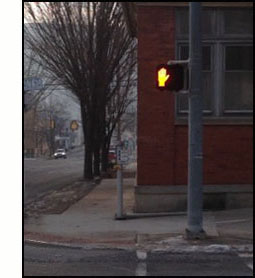
FINALLY, now that we've talked about the importance of pedestrian signals, we're ready to explain how they work!
Basically, pedestrian signals are designed to give time that is long enough for pedestrians to cross, IF they start while the signal says WALK.
The pedestrian signal is divided into three intervals, two of which are the "pedestrian phase" for the crossing (“walk interval” plus the flashing don't walk or "clearance interval"), and the "don't walk" interval. These are the equivalent of the 3 intervals for drivers (green, yellow and red), although they don’t always occur at the same times. The pedestrian intervals are explained in more detail below:

-- Shows a silhouette of a pedestrian walking, or shows the word "WALK."
-- Indicates the time that pedestrians are permitted to START crossing. (Note that this is NOT the time during which pedestrians need to FINISH crossing!)

-- Shows orange flashing hand or flashing words "DON'T WALK," indicating it is too late to START the crossing.
-- Provides TIMING LONG ENOUGH to allow average pedestrians to finish the crossing even if they started just before the signal started flashing with the pedestrian clearance interval. (Note that it does NOT indicate that pedestrians need to hurry up, they just need to complete the crossing in a calm, efficient manner!)

-- Shows solid orange hand or the words "DON'T WALK" (without flashing)
-- Indicates that pedestrians should no longer be in street, because opposing traffic now has the right-of-way (although there may be a few seconds of buffer time or "all-red" before vehicles may begin moving)
- The timing of the two intervals of the pedestrian phase (the walk and the clearance intervals) is pretty straightforward.
The first part of the pedestrian phase, the walk interval, just has to be long enough for pedestrians to start their crossing.
Usually that means just a few seconds, but more time is needed when there are large crowds, so that those who are at the back of the crowd can reach the street and start their crossing.
So sometimes the walk interval is much longer than a few seconds when there are a lot of pedestrians, or when the parallel traffic has a long green signal.
What's critical is the timing of the second part of the pedestrian phase - the pedestrian clearance interval (flashing orange hand or flashing DON'T WALK). The clearance time, which may be a combination of the clearance interval and a buffer interval, is calculated to allow enough time for pedestrians to complete the street crossing, assuming that they started while the WALK signal was still on. The average walking speed of pedestrians was once considered to be 4 feet/second, but the clearance time now is typically figured using a slower pedestrian walking speed of 3.5 feet/second. So engineers calculate the time by dividing the width of the street (measured in feet) by 3.5.
For example, if a street has 5 lanes, each 12 feet wide, how many seconds should the pedestrian clearance time be? If you said about 17 seconds, you'd be correct (5 lanes x 12 feet/lane means the street is 60 feet wide. 60 feet divided by 3.5 feet/second is 17.1 seconds). In this example, the pedestrians would get their WALK signal and then, when there are only 17 seconds left for crossing, the flashing DON'T WALK / flashing orange hand would start. That would last for 17 seconds, and then the don't walk interval would start, and last until the next time that the pedestrians get their turn to cross. There are a number of complex options related to the pedestrian signal display and timing that may result in variations from what's described here, but this is typical.
All right, we can hear you saying "Hey! Doesn't that leave out pedestrians who walk more slowly than 3.5 feet per second?"
Yes, it does! The Manual on Uniform Traffic Control Devices does allow engineers to program a longer pedestrian clearance time where there are elderly pedestrians, pedestrians with disabilities, or where there are numbers of people who walk more slowly, and engineers are supposed to use "engineering judgment" to determine what that timing should be.
There is also an alternate calculation for the pedestrian clearance time that can be used that may make a difference at wide streets. This calculates the entire distance from the pedestrian pushbutton all the way across the street, calculated using a walking speed of 3 feet per second, and compares it to the time provided by the combination of the walk interval and the pedestrian clearance interval. If there is no pedestrian pushbutton, the timing allows for a location 6 feet from the start of the crosswalk.
There are additional features being proposed, such as being able to request a longer crossing time by holding in the pushbutton for more than 2 seconds. These features have not yet been implemented in many locations, due to limitations of current controllers, but may become more common in the future. There are also ongoing experiments with using pedestrian video and microwave detection as they cross the street to make sure they have time, as well as some experiments with smart phone communication that may provide more flexibility in the future.
- The Leading Pedestrian Interval (LPI) is a pedestrian signal timing that is being installed in some modern signal cycles.
In many instances it can reduce conflicts of drivers turning right/left into the pedestrians' crosswalk, which means there will be fewer instances where drivers fail to yield.
However, it has not been shown to reduce conflicts very well in suburban locations where pedestrians are infrequent and the LPI is not displayed very often since there are few pedestrians, and signs for "No Right Turn On Red" may not be installed or may be ignored.
With an LPI, the pedestrians get their turn to cross 3-7 seconds or more before the drivers do. In other words, the onset of the WALK signal is a few seconds before the traffic signal turns green for the vehicles on the parallel street. This means the pedestrians get a head start, and by the time the drivers are allowed to turn into their path, the pedestrians have already "claimed the crossing." Street Films has a delightful video illustrating the LPI, and you can click here for some information about the research and benefits of LPIs for those who can access them.
|
Video illustrates the problem when pedestrians at a Lead Pedestrian Interval have no access to the pedestrian signal.
|
When the LPI is not made accessible, not only are people who cannot see the pedestrian signal unable to benefit from the LPI, they are put at greater risk than they would have been without the LPI!! This is because they usually would wait to cross until they hear the near-lane-parallel traffic surge, which means that 1) they may not have enough time to cross and 2) drivers are less likely to yield to them because they are usually crossing alone, long after the other pedestrians left the curb (research indicates that drivers are more likely to yield to a group of pedestrians than they are to a pedestrian crossing alone). This is explained in the video to the right, which was produced to help traffic engineers and city planners to understand why APS is critical for pedestrian safety when LPIs are installed.
So, for people who are blind or visually impaired to benefit from the safety features of an LPI, there must be an Accessible Pedestrian Signal there. For example, one of the authors noticed that an LPI had been installed at an intersection that she and her blind colleagues had been crossing for many years. Dona Sauerburger writes,
Later I explained the LPI to my client who wanted to cross there. He was never able to recognize when the pedestrian signal changed to WALK until the near-lane-parallel traffic had started surging forward. By then, it was too late to start his crossing because of the aggressive right-turning drivers. They had always been aggressive there (that's probably why the LPI was installed!) but they seemed to become even more so once the LPI was installed, perhaps because when my client didn't start crossing with the WALK signal, the drivers assumed that he wasn't planning to cross. |
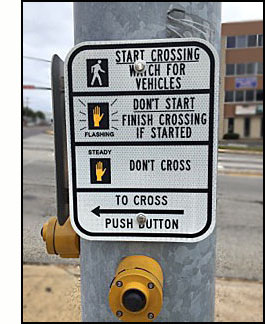 We've explained that at actuated signals, pedestrians need to press the pedestrian pushbutton to let the controller know that they want to cross, so they can be provided a pedestrian phase which gives enough time to complete the crossing.
It is important to realize that if they cross without pressing the pushbutton, even if they start as soon as their signal turns green they may still be in the middle of the street when it changes to red.
We've explained that at actuated signals, pedestrians need to press the pedestrian pushbutton to let the controller know that they want to cross, so they can be provided a pedestrian phase which gives enough time to complete the crossing.
It is important to realize that if they cross without pressing the pushbutton, even if they start as soon as their signal turns green they may still be in the middle of the street when it changes to red.
So let's take a look at how these pushbuttons work and what the controller does when you press them.
What does the controller do when you press the pushbutton?
- When you press the pushbutton, the controller provides a pedestrian phase at the next compatible vehicle movement (phase).
It's rare that the signal begins to change as soon as the pushbutton is pressed -- at really busy intersections, it can take the controller some time to get around to the phase that would be compatible for pedestrians, sometimes as long as several minutes.
- If you press the pedestrian pushbutton . . .
…when the WALK signal is already on for your crossing:
the controller assumes you will start to cross immediately (while the WALK signal is still on). The WALK signal will not come on again unless the pushbutton is pressed again after the walk interval has ended. -
If you press the pedestrian pushbutton . . .
…when your near-lane-parallel traffic has the green signal and your pedestrian signal is displaying steady or flashing "don't walk":
the controller usually gives you the WALK signal the next time that traffic has the green signal except when the controller determines that there is enough time for you to cross now. In that case, it may give you the WALK signal immediately, rather than waiting for the next cycle. This can happen either because - If you press the pedestrian pushbutton . . .
. . . when your parallel traffic has the red signal:
the controller usually gives you the WALK signal the next time the near-lane-parallel traffic has the green signal.- Exceptions are:
- Protected right turns
Sometimes when the near-lane-parallel traffic gets the green signal, they also get a green arrow to turn right (a protected right turn). When this happens, there is no WALK signal when the near-lane-parallel traffic surges forward because the right-turning traffic has the right-of-way, and pedestrians have to wait. An example of this can be seen in a video. - When the controller gives a green signal for vehicles but not the WALK signal (can happen in coordinated systems)
Signals along major roads are often part of a coordinated system of multiple consecutive signalized intersections, where the signals are timed together to keep traffic moving. In these situations, whenever the controller detects that vehicles and pedestrians want to cross the major street and there is enough time for vehicles to cross but not enough time for pedestrians to cross, the controller may give the vehicles a green signal without giving the pedestrians a WALK signal. When this happens and you cannot see or have access to the pedestrian signal, then you have no way to know the WALK signal is not on when the near-lane-parallel traffic surges forward. You can find out if intersections are coordinated by contacting the traffic engineer responsible for that intersection, but be aware that timing and coordination changes can be made overnight from remote locations. - leading pedestrian interval or exclusive pedestrian phasing
- Emergency preemption
In some areas or on some routes, signals have emergency preemption installed to give the right-of-way to emergency vehicles. The approach of an emergency vehicle may increase the length of the green signal for the emergency vehicle, or it may cause the signals to change earlier than usual to give a green to the emergency vehicle and to other traffic on that street. Under emergency preemption, signals are allowed to omit or shorten the pedestrian phase, so pedestrians may not get a WALK signal as expected or the pedestrian clearance time may be shortened.
- Protected right turns
It's extremely important for blind pedestrians who have no access to the WALK signal to know that if you press the pushbutton at the wrong time, you may not get the pedestrian phase when you expect it. So let's look at what could happen, depending upon when you press the pushbutton:
With the exceptions noted above, if you press the pushbutton at the beginning of the surge of traffic on the perpendicular street (the street you want to cross), you can predict that the WALK signal probably begins at the next green signal for your near-lane-parallel traffic. The section on Strategies explains this in more detail.
However, it is important to note that because of the exceptions noted above, if you have access to the pedestrian signal it is always more reliable to cross with the WALK signal than to cross with the surge of the near-lane-parallel traffic.
-
Of course, all this is moot if you don't press the correct pushbutton for your crossing!
But finding the pushbuttons and then figuring out which one is for your crossing can be challenging for pedestrians who are blind, as there is a lack of consistency with their position and location. The 2009 Manual on Uniform Traffic Control Devices specifies that in new installations
- the pushbuttons are to be near the crosswalk line furthest from the center of the intersection, 1.5 - 6 feet from the curb and within 5 feet of the lines of the crosswalk if they had been extended into the sidewalk and
- the face of the pushbutton is to be parallel to the crosswalk it controls.
This means that until all signals and pushbuttons can be retrofitted to comply with the MUTCD standards, the pushbutton may not be near the place where a pedestrian would wait to cross the street, and in some cases it may not even be near the sidewalk. Sometimes there are two pushbuttons on the same pole, one for crossing each street, and often there is no consistency as to whether the pushbutton for a given street is facing the street or perpendicular to it.
So unless the pushbutton and pedestrian signal are made accessible, there is no way for a blind person to know which pushbutton is for which street. There may be an arrow that points to the crosswalk that the pushbutton serves, and signage that explains the pedestrian signal, but this information is not helpful if it is not accessible to pedestrians who are blind. Pushbuttons that are accessible have tactile arrows and may also have speech messages or braille labels that indicate which pushbutton is for which street (see section on APS).
So what should you do if you don't know which pushbutton is for which street? The answer is to press both pushbuttons. We'll talk more about general strategies for using pushbuttons in the section on Strategies.
-
If you've ever wondered how to be sure the controller receives your call, you're not alone!
Let's face it, many pedestrians don't understand how pushbuttons work.
Have you ever seen them standing at the corner pressing the pushbutton rapidly multiple times?
Why do they do that?
Most likely because they don't know if their pushbutton press worked, and if the WALK signal does not light up immediately after they press the pushbutton, they press it again.
They don't realize that, as we explained, the WALK signal usually does not come on so soon after pressing the pedestrian pushbutton!
So how DO pedestrians know if their pushbutton press worked? Some pushbuttons have a light that comes on, or a special sound to confirm that the pushbutton was activated. But many pushbuttons do not have this, so there is no way to be sure that it has been activated. Pedestrians just have to press the pushbutton all the way in and hope it worked and, when possible, verify that the WALK signal comes on.
- Some modern, accessible pedestrian signals (APS) provide extra features when you hold the pushbutton down steadily for a few seconds.
These features may include verbal information about the crossing, an increase in the volume of the audible signal for that crossing during the next pedestrian phase or, if it is feasible, a longer crossing time.
The manufacturers of accessible pedestrian signals offer these special features standard in many of their products. The engineers who install them can choose whether or not to offer the special features, and are often willing to do so if they are requested.
-
As we mentioned in Actuation, some jurisdictions provide pedestrian pushbuttons and signals at all their actuated intersections, but others do not.
The current (2009) edition
of the Manual On Uniform Traffic Control Devices indicates that engineering judgment should determine the need for pedestrian signals and there is no guidance about the need for pushbuttons, so the policy varies among various states, counties and districts.
You should be aware of the policy in the area where you or your students may travel, and the likelihood of having to deal with these kinds of crossings.
- there are enough vehicles waiting to cross on the parallel street that the controller holds the signal green for those vehicles long enough for pedestrians to cross; OR
- the minimum time set for the signal is long enough that if at least one vehicle actuates it, the signal will stay green long enough for pedestrians to cross.
Often, the minimum time for signals for the major street is long enough for pedestrians to cross the minor street, but the minimum time for vehicles on the minor street is often only 5 seconds of green plus 3-5 seconds of yellow. However, engineers can and sometimes do set the minimum time for the minor street signal to be long enough for pedestrians to cross the major street -- an example of this being done at an actuated signal near a school in Maryland is shown in the video above.
For example, in 2017 all actuated signals in California have pedestrian pushbuttons and signals but in Maryland, where more than 95% of the Maryland State Highway Administration signals are actuated, it was estimated that about a fourth of those that are in populated areas do not have pushbuttons or signals for pedestrians. The video to the right illustrates some of these and the issues involved in crossing there.
So what's the big deal?
- When the signal is actuated but there are no pedestrian pushbuttons or signals, pedestrians who want to cross the major street can only hope that there is a vehicle present on the minor street to actuate a green signal.
But getting the signal to change to green is only half the battle -- it needs to stay green long enough for pedestrians to get all the way across. Without having any pedestrian pushbuttons, there are only two ways that this can happen at actuated signals:
- It should be noted that having no pedestrian pushbuttons is NOT a problem at signals that are pretimed -- the signal timing is usually set to provide pedestrians enough time to cross.
This is the case at many intersections in downtown areas, although even there, some signals are being changed from pretimed to actuated.